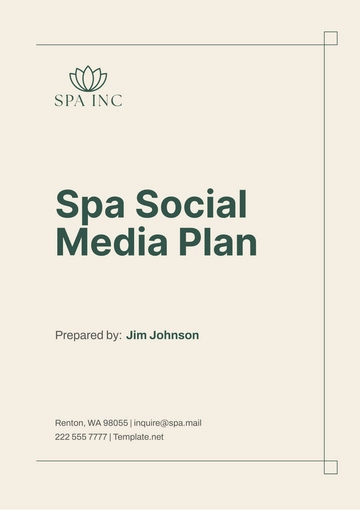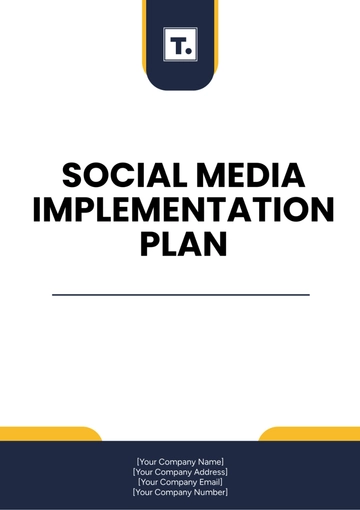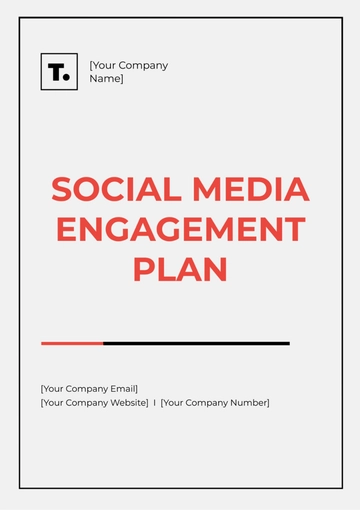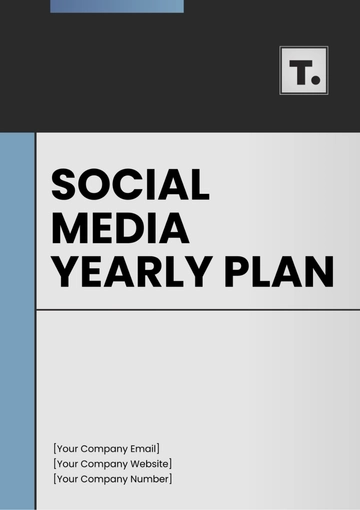Free Yearly Social Media Marketing Advertising Plan

Advertising Plan
I. Executive Summary
This Executive Summary serves as a concise coverage of our Yearly Social Media Marketing Advertising Plan, offering a high-level glimpse into the strategic initiatives that will shape our digital presence over the next [twelve months].
Key Objectives
Within this section, we define our primary objectives, solidifying our aspirations into specific, measurable, and achievable goals. These objectives not only define the outcomes we seek but also articulate a roadmap for realizing our marketing ambitions. The clarity of these objectives is important, forming the foundation upon which the entire plan is constructed.
Target Audience
Understanding our audience is fundamental to our success. In this segment, we will go through the intricate details of our target demographic, exploring their demographics, psychographics, and behavioral patterns. This deeper understanding forms the basis for tailoring our content and advertisements, ensuring resonance with our audience on a profound level.
Summary Of Strategies
From platform selection and content strategy to budget allocation and compliance measures, these strategies serve as the pillars supporting our comprehensive approach to social media marketing. This section acts as a guide for stakeholders through the intricacies of our planned initiatives.
II. Situation Analysis
Market Overview
A comprehensive examination of the market sets the stage for informed decision-making. Analyzing current market conditions, trends, and dynamics provides a contextual understanding of the environment in which our social media marketing efforts will unfold.
Competitor Analysis
A thorough examination of competitors' strategies, strengths, and weaknesses forms a critical aspect of our situational analysis. By identifying competitor positioning, messaging, and tactics, we gain valuable insights that inform the development of a distinctive and competitive social media advertising approach.
SWOT Analysis
Conducting a SWOT analysis elucidates our internal strengths and weaknesses, juxtaposed with external opportunities and threats. This strategic assessment aids in aligning our social media marketing plan with our organizational capabilities while addressing potential challenges and leveraging opportunities in the market.
Key Industry Trends
Staying attuned to industry trends is critical in this dynamic plan. By identifying and understanding emerging trends, we position ourselves to capitalize on opportunities and navigate potential disruptions effectively.
III. Marketing Objectives
Specific And Measurable Goals
In this section, we define the precise marketing objectives that will steer our social media advertising endeavors throughout the year. These objectives are meticulously crafted to be specific, measurable, and aligned with the overarching business strategy.
Alignment With Business Strategy
Our marketing objectives are strategically aligned with the broader business goals, ensuring a cohesive and synergistic approach towards organizational success. Each objective is a deliberate step towards enhancing brand visibility, engagement, and ultimately, achieving tangible business outcomes.
Below is a simplified table outlining objectives for aligning with [Your Company Name]'s plan:
Objective | Description |
Goal Consistency | Align objectives with specific business goals and targets. |
Resource Optimization | Optimize resource allocation to support strategic priorities. |
Performance Metrics | Establish and track key performance indicators (KPIs) that reflect strategic success. |
Risk Mitigation | Identify and address potential risks that may impact the achievement of strategic objectives. |
Continuous Improvement | Implement a feedback loop for ongoing assessment and adjustment of strategies based on changing internal and external factors. |
Key Performance Indicators (KPIs)
To gauge the efficacy of our social media campaigns, we establish clear Key Performance Indicators (KPIs). These metrics serve as quantifiable benchmarks, allowing us to assess performance, measure success, and adapt strategies as needed.
IV. Target Audience Profile
Understanding the intricacies of our target audience is of great import for crafting precise and effective social media campaigns.
Demographic Characteristics
Demographic Factor | Target Audience Profile |
Age Range | 25-40 |
Gender | Predominantly Female |
Location | Urban And Suburban Areas |
Income Level | Middle To Upper-Middle |
Education Level | College Graduates |
The primary demographic focus centers on individuals aged [25-40], predominantly female, residing in urban and suburban areas. These individuals boast a middle to upper-middle income level, with a significant proportion holding college degrees.
Psychographic Insights
Understanding the psychographic nuances aids in tailoring content that resonates with our audience's values and lifestyle.
Lifestyle Preferences: Emphasis on wellness, sustainability, and tech-savvy living.
Interests: Fitness, eco-friendly practices, technology trends.
Values: Social consciousness, work-life balance, continuous self-improvement.
Behavioral Traits
Analyzing behavioral patterns guides the formulation of campaigns that align seamlessly with audience habits.
Online Behavior: Active on social media platforms, particularly Instagram and Pinterest.
Shopping Habits: Prefer online shopping; value product reviews and recommendations.
Content Consumption: Engage with video content, particularly tutorials and product demonstrations.
Understanding these demographic, psychographic, and behavioral facets enables precise targeting and customization of social media content, ensuring resonance and engagement within our defined audience segments.
V. Platform Selection
Evaluation Criteria
In determining the most effective social media platforms, we employ a rigorous set of evaluation criteria. This includes an assessment of user demographics, engagement metrics, and platform-specific features to ensure alignment with our marketing objectives.
Selected Social Media Platforms
After careful evaluation, our chosen platforms are Instagram, LinkedIn, and Twitter. Each platform serves a distinct purpose in reaching our diverse target audience and complements our content strategy.
Rationale For Platform Choices
Instagram: Leveraging visual storytelling for brand engagement, particularly effective for products with a strong visual appeal.
LinkedIn: Targeting a professional audience through thought leadership and industry-related content, enhancing B2B connections.
Twitter: Facilitating real-time engagement and conversation, suitable for timely announcements, promotions, and fostering community interaction.
This strategic selection aims to optimize our social media presence, ensuring a tailored approach for each platform to maximize reach and resonance with our audience.
Content Strategy
The Content Strategy defines a cohesive plan for crafting and disseminating compelling content across chosen social media platforms. It encompasses a meticulous approach to aligning brand messaging, incorporating diverse content types, and implementing a strategic editorial calendar.
Content Types: A variety of content formats, including text, images, and videos, are strategically employed to cater to the preferences of the target audience. This diversification ensures an engaging and dynamic presence on social media platforms.
Brand Messaging: The content strategy prioritizes consistent and resonant brand messaging across all materials. This includes conveying the company's values, mission, and unique selling propositions to fortify brand identity and foster audience connection.
Visual And Multimedia Elements: Integration of visually appealing and multimedia elements enhances the overall impact of content. Infographics, videos, and interactive media are deployed judiciously to captivate the audience and convey information effectively.
Editorial Calendar: A meticulously planned editorial calendar dictates the timing and frequency of content dissemination. Aligned with the yearly campaign calendar, it ensures a steady flow of relevant and timely content.
The Content Strategy serves as the creative backbone, harmonizing the narrative of the brand with the preferences of the target audience, fostering a compelling and sustained online presence throughout the year.
VII. Budget Allocation
Overall Marketing Budget
The annual marketing budget for social media advertising is allocated with precision to maximize impact and return on investment. This budget encompasses all expenses related to strategic planning, content creation, and analytics tools.
Social Media Advertising Budget
The social media advertising budget is strategically distributed across selected platforms, aligning with the target audience and campaign objectives. Rigorous cost-benefit analysis guides this allocation, ensuring optimal utilization of resources for each platform.
Budget Allocation
Budget Category | Allocation |
Content Creation | 25% |
Advertising Space | |
Analytics Tools | |
Contingency And Optimization | |
Miscellaneous |
Cost-Benefit Analysis
A meticulous cost-benefit analysis is performed to justify the allocation percentages. This analysis considers the anticipated returns and effectiveness of each budget category, guiding decisions to optimize resource utilization.
Return On Investment Projections
Projections for ROI are established based on historical data, industry benchmarks, and campaign-specific factors. These projections serve as key performance indicators, allowing for real-time evaluation and adaptation throughout the year.
VIII. Campaign Calendar
The Campaign Calendar provides a condensed monthly synopsis of our social media advertising initiatives, outlining strategic activities and key focal points. Each month is strategically mapped to synchronize with overarching marketing goals, ensuring a cohesive and targeted approach.
This section highlights the incorporation of seasonal and trend-based campaigns, aligning our content with the dynamic interests of our audience. By staying attuned to emerging trends, we aim to capitalize on relevant cultural moments, enhancing engagement and resonance.
Campaign Timing And Duration
Delving into the specifics, this segment delineates the optimal timing and duration for each campaign. Precision in scheduling ensures maximum exposure and impact, utilizing analytics insights and historical data to refine our approach. The calendar serves as a dynamic tool for orchestrating campaigns with agility and adaptability.
IX. Performance Metrics And Monitoring
The Performance Metrics and Monitoring section constitutes a pivotal aspect of our Yearly Social Media Marketing Advertising Plan, offering a concise yet comprehensive overview of the key elements involved in gauging and optimizing campaign success.
Key Performance Indicators (KPIs)
Identify and define a set of clear, measurable Key Performance Indicators (KPIs) aligned with our marketing objectives. These indicators encompass engagement rates, click-through rates, conversion metrics, and return on ad spend (ROAS), providing a focused and measurable framework for assessing campaign effectiveness.
Analytics Tools And Platforms
Select and leverage cutting-edge analytics tools and platforms to track and interpret KPIs accurately. Integration with platforms such as Google Analytics and social media insights tools will facilitate real-time data acquisition, enabling timely decision-making and adaptive strategies.
Reporting Frequency
Establish a structured reporting cadence, outlining when and how performance data will be disseminated. Regular reporting, whether monthly or quarterly, creates transparency and facilitates the swift identification of trends, allowing for agile adjustments to maximize campaign impact.
By implementing this streamlined approach to performance metrics and monitoring, we aim to create a dynamic feedback loop that not only assesses campaign success but also informs strategic refinements for sustained optimization throughout the year.
X. Adaptation And Optimization
In this crucial phase, the Yearly Social Media Marketing Advertising Plan emphasizes continuous adaptation and optimization to ensure the effectiveness of the overall strategy. This section involves a dynamic approach to campaign management, focusing on the following key elements:
Continuous Evaluation Mechanisms
Regular and systematic assessment of campaign performance through real-time analytics and feedback loops. This involves leveraging data-driven insights to identify strengths, weaknesses, opportunities, and threats.
Learning From Insights
A commitment to extracting actionable insights from the gathered data. By discerning patterns, preferences, and trends, the plan facilitates informed decision-making, allowing for the refinement of content, targeting, and overall messaging strategies.
Agile Strategy Adjustments
The plan advocates for an agile approach to strategy adjustments. This involves the prompt incorporation of lessons learned and emerging trends, ensuring the optimization of campaigns in real-time.
XI. Compliance And Ethical Considerations
In adherence to legal and ethical standards, our Yearly Social Media Marketing Advertising Plan prioritizes the following:
Legal And Regulatory Compliance
We commit to upholding all relevant laws and regulations governing social media advertising. This includes, but is not limited to, data protection laws, advertising standards, and intellectual property regulations. Regular legal audits will be conducted to ensure ongoing compliance with evolving legal landscapes.
Ethical Standards
Our social media campaigns will adhere to the highest ethical standards. We pledge transparency, authenticity, and honesty in all communications. Any form of misleading or deceptive content is strictly prohibited. Additionally, we will respect user privacy and ensure responsible data handling practices.
Data Privacy Measures
To safeguard user data, durable measures will be implemented, covering secure data storage, limited access protocols, and compliance with global data protection standards. Users will be provided with clear and concise information about data collection practices, and their consent will be obtained in accordance with applicable regulations.
By prioritizing compliance and ethical considerations, we aim to build trust, foster positive brand perception, and contribute to a responsible and sustainable digital marketing environment.
- 100% Customizable, free editor
- Access 1 Million+ Templates, photo’s & graphics
- Download or share as a template
- Click and replace photos, graphics, text, backgrounds
- Resize, crop, AI write & more
- Access advanced editor
Unlock the potential of your social media marketing with Template.net's Yearly Social Media Marketing Advertising Plan Template. This editable and customizable tool empowers you to craft comprehensive plans tailored to your brand's goals. Leverage our intuitive Ai Editor Tool to adapt strategies seamlessly, ensuring a successful year of advertising campaigns.
You may also like
- Finance Plan
- Construction Plan
- Sales Plan
- Development Plan
- Career Plan
- Budget Plan
- HR Plan
- Education Plan
- Transition Plan
- Work Plan
- Training Plan
- Communication Plan
- Operation Plan
- Health And Safety Plan
- Strategy Plan
- Professional Development Plan
- Advertising Plan
- Risk Management Plan
- Restaurant Plan
- School Plan
- Nursing Home Patient Care Plan
- Nursing Care Plan
- Plan Event
- Startup Plan
- Social Media Plan
- Staffing Plan
- Annual Plan
- Content Plan
- Payment Plan
- Implementation Plan
- Hotel Plan
- Workout Plan
- Accounting Plan
- Campaign Plan
- Essay Plan
- 30 60 90 Day Plan
- Research Plan
- Recruitment Plan
- 90 Day Plan
- Quarterly Plan
- Emergency Plan
- 5 Year Plan
- Gym Plan
- Personal Plan
- IT and Software Plan
- Treatment Plan
- Real Estate Plan
- Law Firm Plan
- Healthcare Plan
- Improvement Plan
- Media Plan
- 5 Year Business Plan
- Learning Plan
- Marketing Campaign Plan
- Travel Agency Plan
- Cleaning Services Plan
- Interior Design Plan
- Performance Plan
- PR Plan
- Birth Plan
- Life Plan
- SEO Plan
- Disaster Recovery Plan
- Continuity Plan
- Launch Plan
- Legal Plan
- Behavior Plan
- Performance Improvement Plan
- Salon Plan
- Security Plan
- Security Management Plan
- Employee Development Plan
- Quality Plan
- Service Improvement Plan
- Growth Plan
- Incident Response Plan
- Basketball Plan
- Emergency Action Plan
- Product Launch Plan
- Spa Plan
- Employee Training Plan
- Data Analysis Plan
- Employee Action Plan
- Territory Plan
- Audit Plan
- Classroom Plan
- Activity Plan
- Parenting Plan
- Care Plan
- Project Execution Plan
- Exercise Plan
- Internship Plan
- Software Development Plan
- Continuous Improvement Plan
- Leave Plan
- 90 Day Sales Plan
- Advertising Agency Plan
- Employee Transition Plan
- Smart Action Plan
- Workplace Safety Plan
- Behavior Change Plan
- Contingency Plan
- Continuity of Operations Plan
- Health Plan
- Quality Control Plan
- Self Plan
- Sports Development Plan
- Change Management Plan
- Ecommerce Plan
- Personal Financial Plan
- Process Improvement Plan
- 30-60-90 Day Sales Plan
- Crisis Management Plan
- Engagement Plan
- Execution Plan
- Pandemic Plan
- Quality Assurance Plan
- Service Continuity Plan
- Agile Project Plan
- Fundraising Plan
- Job Transition Plan
- Asset Maintenance Plan
- Maintenance Plan
- Software Test Plan
- Staff Training and Development Plan
- 3 Year Plan
- Brand Activation Plan
- Release Plan
- Resource Plan
- Risk Mitigation Plan
- Teacher Plan
- 30 60 90 Day Plan for New Manager
- Food Safety Plan
- Food Truck Plan
- Hiring Plan
- Quality Management Plan
- Wellness Plan
- Behavior Intervention Plan
- Bonus Plan
- Investment Plan
- Maternity Leave Plan
- Pandemic Response Plan
- Succession Planning
- Coaching Plan
- Configuration Management Plan
- Remote Work Plan
- Self Care Plan
- Teaching Plan
- 100-Day Plan
- HACCP Plan
- Student Plan
- Sustainability Plan
- 30 60 90 Day Plan for Interview
- Access Plan
- Site Specific Safety Plan





























